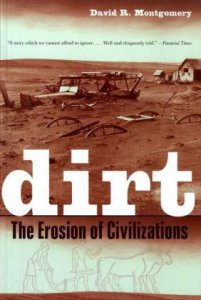 TITLE: Dirt: The Erosion of Civilisations
TITLE: Dirt: The Erosion of Civilisations
AUTHOR: David R. Montgomery, Professor of Earth and Space Sciences at the University of Washington, Seattle, US.
PUBLISHER: University of California Press, Berkeley
PUBLISHING YEAR: 2008
Book review written by: Jane Nebe, Project Researcher (Education and Schools), DIRTPOL Project, Lagos Nigeria.
The author of this book ‘Dirt: The erosion of Civilisations’ is a Geologist and Geomorphologist with research interests in soil topography and geomorphological processes, as it affects human societies and ecological systems. The book won him the 2008 Washington State Book Award in General Nonfiction. The focus of this review is on Chapter one – ‘Good Old Dirt’ and Chapter eight – ‘Dirty Business’. In this book, dirt is conceptualised as the soil. The author however asserts that because the soil is an essential, rich and strategic natural resource that literally supports life, houses and our feet, “good soil is not just dirt” (pg. 1). Soil becomes dirt when land is not conserved and protected, and the topsoil is lost. This leads to the depletion, degradation and erosion of soil fertility.
 According to the author, the loss of soil fertility tends to poverty because the soil can no longer feed those who depend on it. Consequently, civilisations have had to relocate in search of food or land to grow food. Using evidence from historical research, the author claims that “Soil loss contributed to the demise of societies from the first agricultural civilisations to the ancient Greeks and Romans, and later helped spur the rise of European colonialism and the American push westward across North America” (pg. 2). That is, there exists a direct correlation between the state of the soil and a society’s health and resilience. Although, he acknowledged that the factors that led to the collapse of these ancient civilisations are complex, varied and usually multidimensional, he argues that their soil history influenced any other indicting factors. These arguments do not appear unfounded, but he sounded more like an alarmist especially with his pessimism about the future of modern civilisations, because he believes that the soil is not been given the attention it deserves.
According to the author, the loss of soil fertility tends to poverty because the soil can no longer feed those who depend on it. Consequently, civilisations have had to relocate in search of food or land to grow food. Using evidence from historical research, the author claims that “Soil loss contributed to the demise of societies from the first agricultural civilisations to the ancient Greeks and Romans, and later helped spur the rise of European colonialism and the American push westward across North America” (pg. 2). That is, there exists a direct correlation between the state of the soil and a society’s health and resilience. Although, he acknowledged that the factors that led to the collapse of these ancient civilisations are complex, varied and usually multidimensional, he argues that their soil history influenced any other indicting factors. These arguments do not appear unfounded, but he sounded more like an alarmist especially with his pessimism about the future of modern civilisations, because he believes that the soil is not been given the attention it deserves.
In chapter eight, the author chronicles the history of the development of different interventions in Europe to improve soil fertility. Old agriculture had relied on practices like crop rotation, fallowing, mulching and manuring to enhance soil fertility. Modern Agriculture now rely on the use of fertilizers. I would like to highlight two incidences relevant to the DIRTPOL project, which the author described in relation to animal waste used positively and profitably. On a research expedition to Tibet, the author had earlier observed that Tibetan livestock like pigs and cattle manured the farms during the day and returned home at night. Having to spend a night in a cheap hotel where:
Homemade sleeping platforms served as beds in sleeping stalls barely separated by unfinished plank walls. The propreitor advised us on our way in that the backyard would serve as our bathroom. That the pigs clean up the yard bothered me during our pork dinner [emphasis mine]. Still, I had to appreciate the efficiency of pigs eating waste and fertilizing the soil, and then people eating both crops and pigs. Overlooking the obvious public health issues, this system sustained soil fertility (pp 179-180).
 This incidence is striking in light of the objectives of the DIRTPOL project. People’s perception of animals and their relationships with different animals can give great insight into the ‘dirt’ discourse. For example, in some cultural context, dogs and cats as pets do not stay in the house. In other cultural context, dogs and cats as pets stay in the house. I interviewed a man who would not eat dog meat because he likes dogs and therefore feels it would be cruel to eat it. Others do not eat dogs for religious reasons while some do not eat dogs because it eats excreta. Of course, there were those who eat dog meat. On social media, a friend put up a picture of her cat licking her cheese. I know that I would throw away the cheese licked by a cat (I actually found the picture disgusting). But of course, my friend who is an Asian did not. Thus, the mediation of religious, cultural, personal and health categories in the dirt discourse are worthwhile leads for the project.
This incidence is striking in light of the objectives of the DIRTPOL project. People’s perception of animals and their relationships with different animals can give great insight into the ‘dirt’ discourse. For example, in some cultural context, dogs and cats as pets do not stay in the house. In other cultural context, dogs and cats as pets stay in the house. I interviewed a man who would not eat dog meat because he likes dogs and therefore feels it would be cruel to eat it. Others do not eat dogs for religious reasons while some do not eat dogs because it eats excreta. Of course, there were those who eat dog meat. On social media, a friend put up a picture of her cat licking her cheese. I know that I would throw away the cheese licked by a cat (I actually found the picture disgusting). But of course, my friend who is an Asian did not. Thus, the mediation of religious, cultural, personal and health categories in the dirt discourse are worthwhile leads for the project.
The second incidence was the discovery of large deposits of guano, the bird droppings of nesting sea beds, off the coasts of Peru in the early 19th century. Guano had strong fertilizing effects because it is rich in phosphates and Nitrogen. Here, the author paints a picture of large importation of guano and the colonizing activities of some European countries to grab guano islands. The author also describes how the colonialists appropriated the best lands for export crops in developing countries. The relationship between the Colonialists, the colonised and the soil (in terms of its assets) is examined and one tends to agree with the author’s argument that the soil played a role in spurring European colonialism.  A retrospective look at Nigeria’s colonial history affirms this with the exportation of her crude oil and the cocoa cash crop. There is a common perception by Nigerians that the British who colonised Nigeria robbed her greatly. An interview I had with an education official also reflects this. Since one of the themes of the project is colonialism, with an interest to study the concept of dirt from the period of the consolidation of colonialism in the 1880s through to the present, in Lagos and Nairobi, it provides great perspective for some of the issues revolved around colonialism.
A retrospective look at Nigeria’s colonial history affirms this with the exportation of her crude oil and the cocoa cash crop. There is a common perception by Nigerians that the British who colonised Nigeria robbed her greatly. An interview I had with an education official also reflects this. Since one of the themes of the project is colonialism, with an interest to study the concept of dirt from the period of the consolidation of colonialism in the 1880s through to the present, in Lagos and Nairobi, it provides great perspective for some of the issues revolved around colonialism.
Indeed, I found the book very interesting and insightful. However, one might need a certain degree of disciplinary situated knowledge to flow with the author’s ideas. I had to keep making recourse to the agricultural lessons learnt during my secondary school education to fully grasp the trend of some of his arguments. I would not want to give conclusive opinions about this book, considering that I read just two of the book’s chapters. Nonetheless, I must say that Professor David Montgomery’s arguments were presented in a logical and factual manner based on extensive social-historical research. His book throws more light on the valuations and uses of dirt positively, while calling on its readers to be more proactive in conserving the soil.
About the author: Jane Nebe is a project researcher on the DirtPol project and is concerned primarily with issues pertaining to dirt in education and schools. Jane is based in Lagos, her academic background is in pedagogy and she speaks Igbo,Yoruba, Nigerian Pidgin and English.
About the project: DirtPol is an international cultural studies project based at the University of Sussex. For more information please visit the DirtPol website.


Leave a Reply